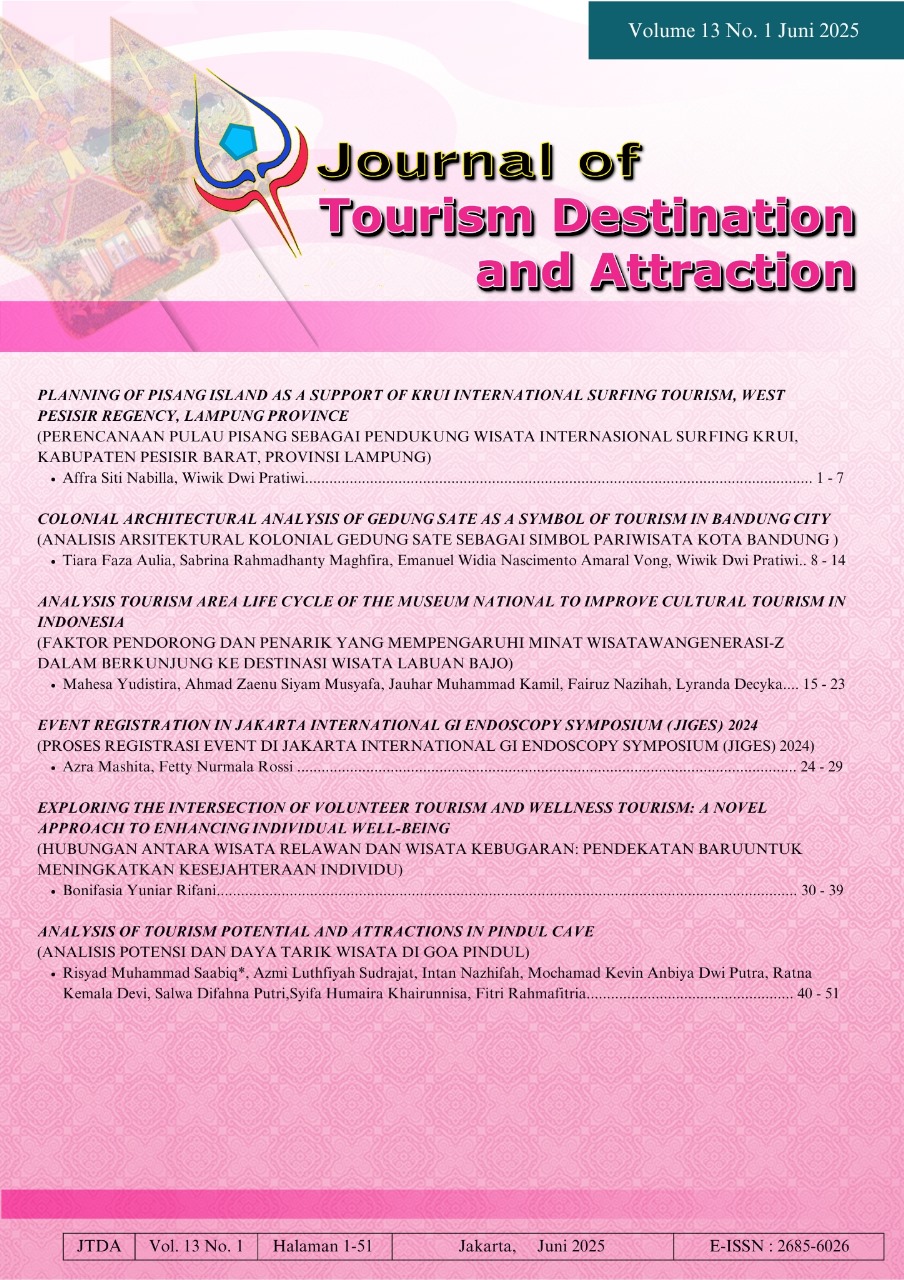COLONIAL ARCHITECTURAL ANALYSIS OF GEDUNG SATE AS A SYMBOL OF TOURISM IN BANDUNG CITY
DOI:
https://doi.org/10.35814/rgbmac95Keywords:
Gedung Sate, Architectural Analysis, Tourism, Cultural Heritage, Tourism Planning., Architectural Analysis, Tourism, Cultural HeritageAbstract
Analyzing the architectural features of Gedung Sate reveals its significance as a historical and cultural landmark in Bandung, Indonesia. Constructed in 1920 by architect Ir. J. Gerber, the building showcases a unique blend of European and Indonesian styles, characterized by its neoclassical design with Art Deco influences and the iconic "tusuk sate" ornamentation. Originally serving as the headquarters for the Dutch colonial government, Gedung Sate has evolved into a vital component of Bandung's tourism landscape, attracting both local and international visitors. Despite its popularity, the building's potential as a nighttime tourist destination remains largely untapped. This research evaluates the architectural elements that enhance its appeal and proposes strategies for optimizing its use as a cultural and educational site. The findings aim to contribute to the understanding of the relationship between architecture and tourism while offering practical recommendations for stakeholders to improve visitor experiences and promote sustainable tourism development in Bandung.
References
Andayani, G. S., Dermawati, D., & Puspatarini, R. A. (2019, September). Penerapan Pendekatan Arsitektur Ikonik Pada
Fasad Bangunan Kawasan Pasar Johar Semarang. In Prosiding Seminar Intelektual Muda (Vol. 1, No. 2).
Harahap, Y., Mangkuto, R. A., & Soelami, F. X. N. (2009). Lighting Design for Axis of Gedung Sate and Monument of West Java People's Struggle. In conference; ITB International Conference on Regional Development, Environment and Infrastructures; 2009-06-18; 2009-06-19 (pp. 1-7). Institut Teknologi Bandung.
Holloway, J. C., & Humphreys, C. (2022). The business of tourism.
Kusbandiah, D., & Wisnuadji, S. (2024). Signifikansi Arsitektur Dinding Interior pada Bangunan Heritage Gedung Sate Jawa Barat. Dinasti Information and Technology, 1(3), 96-108.
Meidiria, I. G. A. C. C. (2017). Gedung Sate, Keindahan Ornamen Arsitektur Indo-Eropa. In Seminar Ikatan Peneliti Lingkungan Binaan Indonesia (IPLBI) (Vol. 1, pp. A321-A326).
Pawitro, U. (2012). Perkembangan ‘arsitektur ikonik’di berbagai belahan dunia. Majalah Ilmiah TRI-DHARMA Kopertis Wilayah IV Jabar & Ban Ten, Bandung, Nomor, 1.
Sadli, M., Prawira, C. J., & Dikusuma, R. I. (2015). Adaptasi Bangunan Baru Terhadap Bangunan Lama di Kawasan Konservasi Gedung Sate Bandung. Reka Karsa: Jurnal Arsitektur, 3(3).
Yabanci, O. (2022). Historic architecture in tourism consumption. Tourism Critiques: Practice and Theory, 3(1), 2-15.























